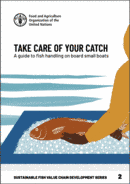Misuse of Veterinary Drugs
Problems related to the use of antimicrobials, contaminated feed and pesticide residue in water can cause high levels of contaminants in harvested fish. This can lead to food safety concerns and the rejection of harvested product. Rejected product is, in turn, usually destroyed.
Human health risks arise from pathogens and the spread of disease vectors, chemicals and toxins, and abuse of antibiotics. The risks associated with chemicals and toxins arise from several sources, including veterinary drug residues, agricultural chemicals, pesticides, and accumulation of other pollutants. In addition, under certain conditions, some cultured species can produce toxins. Poor farming practices have led to major commercial losses when importing countries have placed import restrictions on shrimp and other products from Asia and Latin America as a result of unacceptable levels of antibiotic residues in products. Pesticides and piscicides (chemicals to kill fish) present a risk to human health, and their use must be carefully monitored. High levels of polychlorinated triphenyls (PCBs), dioxins, and other contaminants have been reported in farmed salmon and attributed to the bioaccumulation in the fish meal feed. Metals from mining, use of antifouling agents, or natural sources can also accumulate in the edible tissues of cultured fish—in particular, of invertebrates. The levels of mercury and organochlorides in fish are a public health concern.
The key causes of food loss and waste (FLW) associated with the use of drugs and contaminants include:
- Marine toxins – paralytic shellfish poisoning, neurotoxic shellfish poisoning, diarrhetic shellfish poisoning, amnesic shellfish poisoning and ciguatera fish poisoning
- Environmental contaminants and pesticides – including methyl mercury and radionuclides
- Aquaculture drugs – unapproved drugs or unapproved applications
- Food and colour additives – unapproved or improperly declared; sulphites, borates, nitrate/nitrite, cyclamate, saffron, FD&C Yellow No. 5, FD&C Red Approaches No. 4
Issue of Antibiotic Residues in Cultured Fish and Shrimp
Issue of Antibiotic Residues in Cultured Fish and Shrimp
As recognition of the importance of aquaculture as a major protein source for human nutrition is growing, the issue of antibiotic residues in cultured fish and shrimp is increasing as well. To reduce potential disease risks, fish farmers often use antimicrobial agents during production. Misuse, overuse and improper withdrawal periods of antimicrobials could result in harvested products containing certain chemicals above the established maximum residue levels (MRL). As these products pose a health risk to consumer, they are not allowed on the market. This leads to disposal of product, therefore contributing to food loss and waste (FLW), as well as a loss in economic value to the producer.
Harvesting from Contaminated Waters
Harvesting from Contaminated Waters
Fish can be harvested from waters that are contaminated by varying amounts of industrial chemicals, including heavy metals and pesticides. These contaminants may accumulate in fish at levels that can cause human health problems (e.g., carcinogenic and mutagenic effects). The hazard is most commonly associated with exposure over a prolonged period of time (chronic exposure). Illnesses related to a single exposure (one meal) are very rare. Concern for these contaminants primarily focuses on fish harvested from aquaculture ponds, freshwater bodies, estuaries, and near-shore coastal waters (e.g., areas subject to shoreside contaminant discharges), rather than from the open ocean. Environmental chemicals and pesticides may also accumulate in aquacultured fish through contaminated feed ingredients (e.g., pesticides in oil-containing feed ingredients derived from near-shore bait fish).
Other Major Concerns
Other Major Concerns
Other major concerns which cause food safety concerns and market rejection include environmental chemical contaminants, food safety and traceability. For example, pesticide residues can still be found in cultivated fish. Pesticides may come from underground water sources used for aquaculture. Aquaculture feeds have also been linked to the concentration of contaminants such as dioxin in certain farmed fish.
In the case of aquaculture, the primary potential chemical hazards of concern include intentionally added chemicals such as veterinary drugs used in aquaculture production and unintentional contaminants such as persistent environmental contaminants that might be present in the production areas. In addition, certain types of marine fish naturally contain toxic compounds or may be particularly susceptible to contamination with naturally-occurring toxins, although they generally are not hazards of concern in the predominant species used in aquaculture.
Information on the permitted levels or maximum residue levels (MRL) of various veterinary drugs and other substances are provided by the Codex Alimentarius Commission.
Key Publications
|
This study provides strategic orientations and recommendations for countries and suggests approaches for the World Bank’s role in a rapidly changing industry with high economic potential. |
| |
Environmental Chemical Contaminants and Pesticides From the US FDA Fish and Fishery Products Hazards Guide. | ||
Causes of detentions and rejections in international fish trade Failure to meet market requirements in terms quality and safety will often result in rejections of consignments and FLW. |
More Resources
More Resources
31 October 2023














